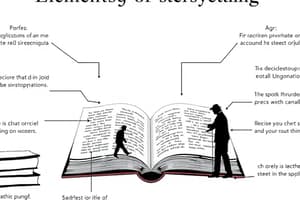Podcast
Questions and Answers
La exposición de una historia es donde se resuelve el conflicto principal.
La exposición de una historia es donde se resuelve el conflicto principal.
False (B)
La acción ascendente se caracteriza por una serie de complicaciones que conducen a confrontaciones inevitables.
La acción ascendente se caracteriza por una serie de complicaciones que conducen a confrontaciones inevitables.
True (A)
El clímax de una historia es el momento de máxima tensión donde se resuelve el conflicto central.
El clímax de una historia es el momento de máxima tensión donde se resuelve el conflicto central.
True (A)
La acción descendente es donde se introduce a los personajes y el conflicto principal de la historia.
La acción descendente es donde se introduce a los personajes y el conflicto principal de la historia.
La resolución de una historia representa la estructura de la historia y cómo se encadenan los eventos.
La resolución de una historia representa la estructura de la historia y cómo se encadenan los eventos.
La acción ascendente es donde se determina si el protagonista triunfa sobre la adversidad o sucumbe a ella.
La acción ascendente es donde se determina si el protagonista triunfa sobre la adversidad o sucumbe a ella.
El desenlace es lo último que sucede en una historia y permite a los lectores comprender la importancia de cada evento.
El desenlace es lo último que sucede en una historia y permite a los lectores comprender la importancia de cada evento.
La acción que sigue al clímax se llama 'acción ascendente'.
La acción que sigue al clímax se llama 'acción ascendente'.
La comprensión y aprecio por las obras literarias solo es posible para autores profesionales.
La comprensión y aprecio por las obras literarias solo es posible para autores profesionales.
Los cinco aspectos estructurales principales permiten a los escritores crear historias que resuenen con los lectores.
Los cinco aspectos estructurales principales permiten a los escritores crear historias que resuenen con los lectores.
El desenlace proporciona cierre pero no ofrece visión sobre el viaje interno de los personajes.
El desenlace proporciona cierre pero no ofrece visión sobre el viaje interno de los personajes.
Flashcards are hidden until you start studying
Study Notes
Unlocking Storytelling's Building Blocks: Understanding Connections Between Parts
Storytelling is a fundamental human experience where we create narratives through various elements working together like pieces of a puzzle. This exploration delves into how these different elements — or "parts," if you will — connect within a story, forming cohesive sequences that captivate audiences and convey meaningful messages.
The crux of our narrative lies with its components: exposition, rising action, climax, falling action, and resolution represent the story's structure. Each part contributes something unique; let's take a closer look at how they intertwine to form solid storylines.
Exposition
An introduction to characters, setting, and conflict sets the foundation for all subsequent events. It lays out what readers need to know before diving deeper into the plot, providing context crucial to understanding everything else.
Rising Action
Following exposition comes rising action, which unfolds through a series of complications leading up to unavoidable confrontations. Conflict intensifies during this phase, causing characters to act in response to their circumstances.
Climax
As tension reaches its peak, the climatic moment arrives, resolving the central conflict and determining whether the protagonist prevails over adversity—or succumbs to it.
Falling Action
After the climax, the falling action brings resolution by wrapping up loose ends and demonstrating outcomes based on decisions made throughout the tale.
Resolution
Lastly, the resolution ties together all elements and allows readers to understand the significance of each event, leaving them satisfied with the conclusion. It provides closure while also offering insight into characters' inner journeys.
By knowing and understanding these five core structural aspects, writers can develop engaging stories that resonate with readers, conveying themes and ideas effectively. However, mastering these connections isn't just limited to professional authors. By analyzing literature using such frameworks, anyone interested can deepen comprehension and appreciation for works old and new alike!
Studying That Suits You
Use AI to generate personalized quizzes and flashcards to suit your learning preferences.



